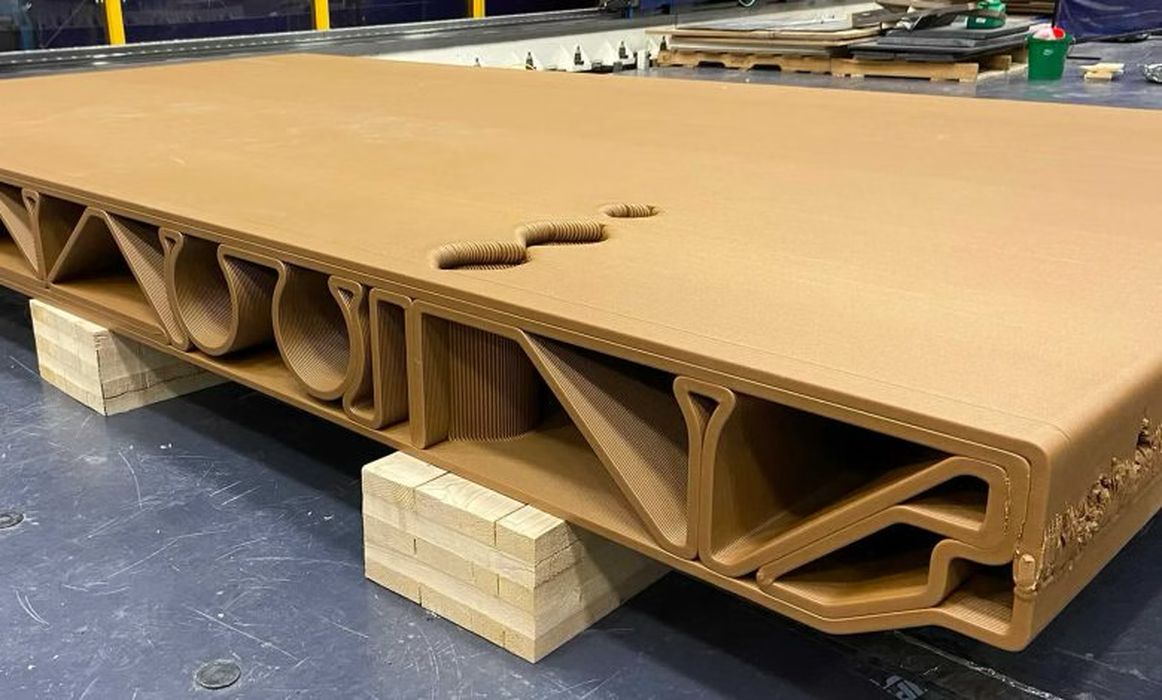
The SM2ART Nfloor cassette panel, developed by ORNL and the University of Maine, was created using LFAM and PLA.
Researchers at the Department of Energy’s Oak Ridge National Laboratory and the University of Maine have designed and 3D printed a single-piece, recyclable natural-material floor panel tested to be strong enough to replace construction materials like steel. The project is part of the Sustainable Materials & Manufacturing Alliance for Renewable Technologies, or SM2ART, program.
The SM2ART team previously constructed BioHome3D, the nation’s first additively manufactured home made entirely from biologically based materials. BioHome3D’s components and the floor panel were recently displayed during the US Department of Housing and Urban Development’s 2024 Housing Innovation Showcase on the National Mall.
The SM2ART Nfloor cassette panel was developed to replace traditional steel-and-concrete surface assemblies as a transformative step for constructing apartment and condominium buildings. The technology has the potential to create strong, biologically based sections that could make multistory buildings more environmentally friendly. It could also help increase the use of sustainable structures that are made in a modular construction facility.
Modular manufacturing creates complete sections of a building at an offsite factory before delivery to a construction site for final assembly. The method is becoming a cost-effective way to develop sustainable residential structures in urban areas.
“By utilizing bio-based, large-scale 3D printing, we replaced an assembly made from 31 parts and three materials with a single-material floor panel that is ecologically friendly, and with the same strength as traditional steel floor fabrication,” said Katie Copenhaver, a researcher at ORNL.
The SM2ART floor cassette’s sturdiness comes from its unique formulation of PLA – a biodegradable thermoplastic-polyester bioplastic derived from corn residue and wood flour made from the waste of lumber processing. “The PLA and wood flour blend is an excellent material for producing recyclable, large-format additively manufactured parts,” said Scott Tomlinson, a structural engineer at the University of Maine’s Advanced Structures and Composites Center. “This single-piece floor assembly is stiffer and provides an improved walking experience when compared to the steel-concrete assembly it replaces.”
To construct the floor panel, researchers used a large-scale 3D printer to deposit the PLA/wood flour mixture in a precise, geometric shape. By working continuously and autonomously, the printer produced the SM2ART Nfloor cassette in about 30 hours. The process created a labor savings of about 33% compared to the effort needed to construct a similar steel floor assembly by hand.
A significant cost of a traditional steel frame comes from workers cutting channels for electrical conduit, plumbing lines, and ductwork for heating, ventilation, and air conditioning after the steel floor assembly is nearly completed. “3D printing can save time and money by printing the floor cassette with cutouts designed into the finished product,” said Copenhaver. “The only human labor involves installing acoustic skin for soundproofing and the resident’s desired floor covering.”
The SM2ART Nfloor cassette is also fully recyclable. Unlike building materials that are hauled to a landfill after a traditionally constructed building reaches the end of its useful life, PLA is a renewable material that can be repurposed to make other products after demolition.
Read the rest of this story at VoxelMatters
